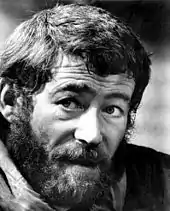Cultural depictions of Henry II of England
Henry II ruled as King of England from 1154 to 1189 and at various times he also partially controlled Scotland, Wales, Ireland and the Duchy of Brittany. He has been depicted in various cultural media.
Theatre and film

Henry II appears as a character in several modern plays and films. He is a central character in James Goldman's 1966 play The Lion in Winter, set in 1183 and presenting an imaginary encounter between Henry's immediate family and Philip Augustus over Christmas at Chinon. The 1968 film adaptation communicates the modern popular view of Henry as a somewhat sacrilegious, fiery and determined king although, as Goldman acknowledges, Henry's passions and character are essentially fictional.[1][2] The Lion in Winter has proved to be an enduring representation of Henry, being turned into an Academy-Award-winning film and remade in 2003 for television.
The relationship between Henry and Thomas Becket has been a rich source for dramatic interpretation, for example as early as 1923 in the film Becket. In the play Becket by Jean Anouilh, (filmed in 1964), the character of the King is deliberately fictitious, driven by the need to enhance the drama between them.[3] The Becket controversy also forms the basis for T. S. Eliot's play Murder in the Cathedral, where the tensions between Henry and Becket allow a discussion of the more superficial events of Becket's death and Eliot's deeper religious interpretation of the episode.[4] Murder in the Cathedral was adapted for a feature film in 1951, directed by George Hoellering: in this version Alexander Gauge played Henry.[5]
Beth Flintoff has written a trilogy of plays which feature Henry II, his mother Matilda and grandfather Henry I . These are fictionalised accounts of historic events. The first, Henry I of England,[6][7] sets the scene by including the foundation of Reading Abbey in 1121 and the second Matilda the Empress shows the future Henry II as a child during The Anarchy period after Henry I’s death when Matilda and her cousin Stephen were rivals for the succession.[8] In the concluding part, Henry II, which was first performed in October 2018 at Reading's Minster Church of St Mary the Virgin, the king is the main focus. The action of the play is set over the Easter weekend of 1164 when Thomas Becket officiated at the dedication of the then-complete Abbey, of which Henry II was an important patron.[1][9]
Historical fiction and television drama
- Walter Scott wrote a novel The Betrothed (1825), which features Henry II as a character.[10]
- Thomas Miller wrote a three-volume historical romance Fair Rosamond; or The Days of King Henry II, first published in 1839.[11]
- Catherine Maberly's 1851 novel The Lady and the Priest is about Henry and his relationships with his mistress Rosamund Clifford, and his antagonist, Thomas à Becket.[12]
- Henry Bailey's novel The Fool, published in 1921, focused on the young Henry II. [13]
- Alfred Duggan's novel God and My Right (1955) revolves around the conflict between Henry and Thomas à Becket.[14]
- In 1978, the BBC broadcast The Devil's Crown, a thirteen-part series dramatising the reigns of Henry II and two of his sons.
- Ken Follett's novel The Pillars of the Earth, published in 1989, features Henry II. The Pillars of the Earth became his best-selling work and was adapted as a television miniseries and a video game
- Sharon Penman has written several novels in her Plantagenet series about Henry II and his wife Eleanor of Aquitaine
- Ariana Franklin's novel Mistress of the Art of Death (2007) is set in the 12th-century during Henry II's reign
- Elizabeth Chadwick has written a series mainly concerned with Eleanor of Acquitaine in which Henry II is a major character
- Alison Weir has written a biography of Eleanor of Aquitaine, and a novel The Captive Queen (2010) based on this work. The Captive Queen features Eleanor's relationship with Henry as part of its plot. [15]
- In the video game Age of Empires II HD: The African Kingdoms, Henry II featured as a two-handed swordsman.
Further reading
- Kevin J. Harty, The Reel Middle Ages: American, Western and Eastern European, Middle Eastern and Asian films about Medieval Europe, 1999, ISBN 0-7864-0541-4
References
- Martinson, Amanda A. (2007). The Monastic Patronage of King Henry II in England, 1154–1189 (Ph.D. thesis). St Andrews, UK: University of St Andrews. hdl:10023/470.
- Palmer, R. Barton (2007). "Queering the Lion Heart: Richard I in The Lion in Winter on Stage and Screen". In Kelly, Kathleen Coyne; Pugh, Tison (eds.). Queer Movie Medievalisms. Farnham, UK: Ashgate. p. 46. ISBN 978-0-7546-7592-1.
- Carlson, Marvin (1995). "Jean Anouilh" in Reference Guide to World Literature. Vol 1. New York: St. James Press. ISBN 1558623329.
- Tiwawi, Subha; Tiwawi, Maneesha (2007). The Plays of T.S. Eliot. New Delhi: Atlantic. p. 90. ISBN 978-81-269-0649-9.
- The New York Times Movie Reviews Murder in the Cathedral; Retrieved on 24 May 2020.
- Moss, Stephen (2016-11-02). "Henry I leads the charge to crown Reading as a cultural hotspot". The Guardian. Retrieved 2018-12-03.
- "Review of Henry I of England". British Theatre Guide. Retrieved 2018-12-03.
- "Review of Matilda The Empress". The Stage. Retrieved 2018-12-03.
- "Review of Henry II". The Stage. Retrieved 2018-12-03.
- Wagenknecht, Edward. Sir Walter Scott. New York : Continuum, 1991. ISBN 9780826404916 (p. 92)
- "Fair Rosamond". ASIN B004W4M47W.
- McGarry, Daniel D., White, Sarah Harriman, Historical Fiction Guide: Annotated Chronological, Geographical, and Topical List of Five Thousand Selected Historical Novels. Scarecrow Press, New York, 1963 (p. 62)
- "Review of The Fool by H.C. Bailey". The Queenslander, 4 Feb 1922. (p.3)
- Cam, Helen Maud. What of the Middle Ages is alive in England today? University of London, Athlone Press, 1961 (p.25)
- Jones, Barney (August 13, 2010). "Review:Captive Queen". The Globe and Mail. Retrieved March 22, 2020.